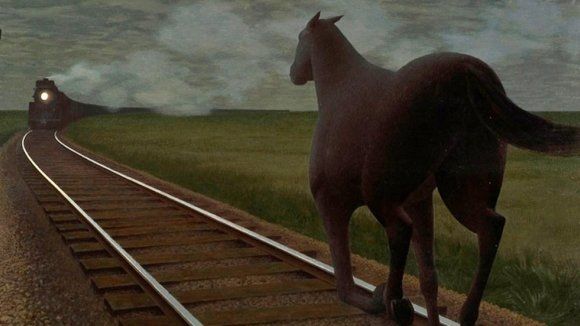

The pictures of Canadian artist Alex Colville bear more affinity to the American Precisionists of the 1930s than to photo-realism. His perfect compositions are based on an abundance of sketches and studies, which are first brought into an abstract, geometric scheme before drawings are made from the live model and proportioned according to the planned format. Only then does the slow and patient process of painting begin. Layer upon layer of thinned paint is applied to a primed wooden panel, and the opaque surface finally sealed with transparent lacquer. The process can often take months.
Colville has devoted intensive study to European painting. According to him, it took him many years to digest the impressions gained during two days spent in the Louvre. Yet he has also been deeply impressed by the American Luminists, and not least by Hopper. Colville’s paintings are proof of the fact that a realism of content need have nothing in common with naturalism, that the serious realist does not unthinkingly reflect reality, but analyses it. It is this analytical cast of mind, Colville is convinced, that permits him to discover “myths of mundanity” — on the banks of the River Spree, by the seaside, in the circus, at sports events, on a boat or a highway, in a meadow or a swimming pool, in a telephone booth or a bedroom. Colville insists that the mythical aspect of everyday life is not reserved for authors of the secular rank of a James Joyce, but that the contemporary painter can have access to is as well.
Colville’s silent images are static. Yet practically all of them tell a story, in a brief, concise plot that does not always have a resolution. Fundamental human situations are their both simple and complex themes: loneliness, isolation, parting, work, leisure, estrangement, love. The only subliminally dramatic, often melancholy laconism of content corresponds to the absolute precision of form by which it is conveyed. Like hardly another artist, Colville maintains the difficult balance between imagination and sober calculation, formal interest and social commitment. Behind the realistic surface of his imagery lurks the surreal – but a surreal that lacks every trace of theatrical staging or borrowing from psychoanalysis, whose new myths Colville deeply mistrusts.
.
— From Art of the Twentieth Century, ed. Ingot. Walther. Vol. I Taschen, Koln, 1998
.
Behind his words, as behind his art, you can sense elaborate webs of thought. And, also like his paintings, he stands quite alone, beyond category. It’s impossible to speak with him for a few hours without feeling his powerful sense of self. He is, it seems, a free man.
.
— Robert Fulford, Regarding Alex Colville, Saturday Night, 17 June, 2000
.
